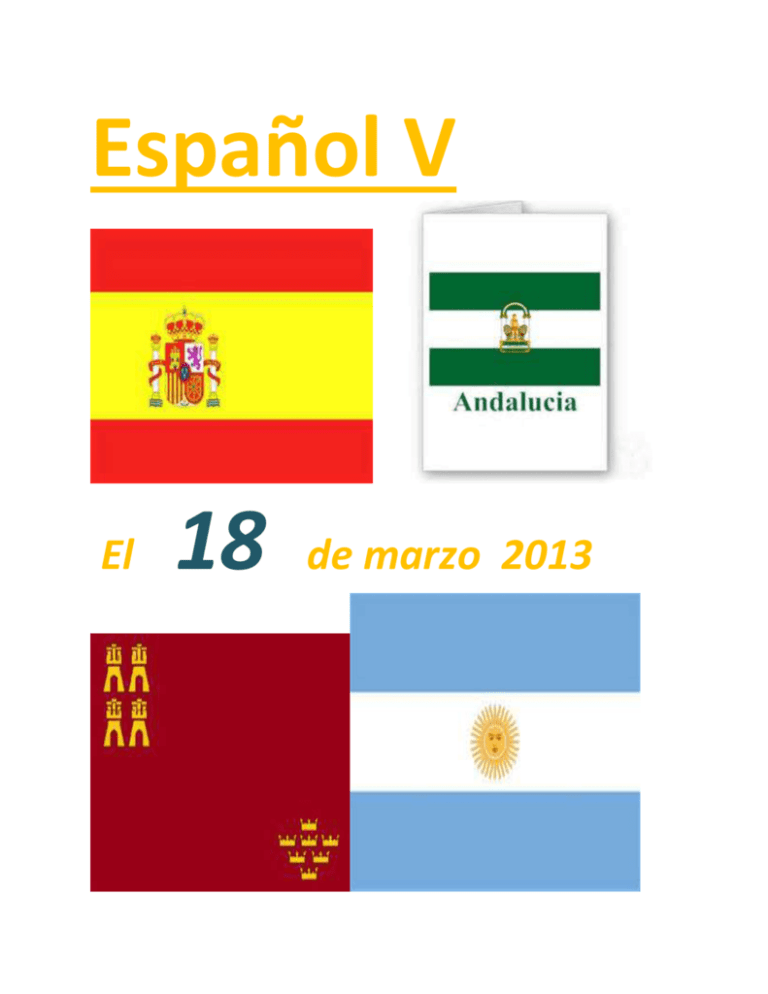El 18 de Marzo 2013
advertisement

Español V El 18 de marzo 2013 META: el 18 de marzo 201 META examen mañana- Capítulo 6 Repaso de las páginas del libroPáginas 68-69 A primera Vista I todo Joan Miró Páginas 70 -71 Dina Brurstzyn Carlos Entiquez Oswaldo Guayasamín Diego Rivera Manos a la Obra Páginas 72-73 Alfonso Fernández Diego Rodriguez de Silva y Velázquez Páginas 74-75 Joan Miró Salvador Dalí Diego Rivera Páginas 76-80 Pretérito vs Imperfecto Gramática Artista Remedios Varo -Maria de los Remedios Varo y Urunga Páginas 78-79 David Alfaro Siqueiros Estar + Participio gramática Páginas 80-81 Pepón Osorio Museo del Barrio en New York, New York Páginas 82-83 Vocobulario y verbos A Primera Vista II Reseñas de periódicos y catálogos. Páginas 84-85 Espectáculos del mundo latino Páginas 86-87 Manos a la obra 2 vocabulario Página 88 SER and ESTAR importante Página 90 VERBOS CON DISTINTOS SENTIDO en el Pretérito y en al imperfecto Página 93 Zarzuela Páginas 94 – 95 FRANCISCO GOYA Cuando era Puertorrriqueña Páginas ¡Adelante! 100-103 ¡Fíjense! ¿Comprendiste? Was due today Monday 18 of March 2013 ¡¡¡¡¡¡DUE MAÑANA!!! Examen mañana Capítulo 6 Comienza el 19 de marzo 2013 3. El PAQUETE de Capítulo 2 Repasen Uds. Al continuar como repaso para el examen.... Página 25 Página 26 Página 27 Pagina 28 Página 29 Página 32 4. Repasen el Capítulo 2 Los artistas y la gramática ¿ COMPRENDISTE ? página 103 El Pretérito y el imperfecto Preterit vs. imperfect The preterite and imperfect are both simple (i.e., noncompound or one-word) tenses indicating a past-time action or state. Sometimes a given English past-tense sentence may be translated into Spanish with either the preterite or the imperfect, but these two tenses have different meanings or implications. imperfect The tense may be considered the present tense back shifted into past time. It is generally used to indicate: 1. A past action or state being viewed as in progress. In English we often use the past progressive for this: “was/were ...-ing” Mirábamos las mariposas. We were watching the butterflies. Mientras ella abría la puerta... As she opened (was opening) the door... 2. Two frequent examples of states in past time which are normally viewed as in progress and thus given in the imperfect: Descriptions in past time, that is, what a person, thing, or situation was like. This also includes situations such as giving the time of day, the date, the weather, one's age, etc. (unless a change or the start/end of a state is indicated, in which case the preterite is normally used). Mi madre buena era muy baja, tenía 40 años, y trabajaba sin fin. My mother was very short, was 40 years old, and worked constantly. Eran las diez de la noche, había una tormenta terrible, y teníamos miedo. It was 10:00 at night, there was a terrible storm out, and we were afraid A. Mental states (in progress) in past time. No lo sabía. I didn't know it/that. Creíamos que estábamos perdidos.- We thought we were lost. 3. A past action viewed as being customary or habitual. Note that English often uses “would” or “used to” to indicate this. En México, yo caminaba por la playa y las gaviotas hacían círculos sin terminar en el cielo. In Mexico, I used to walk along the beach and the seagulls would make endless circles in the sky. preterite The tends to “freeze” an action or state in past time, or to view it as over and done with. It is used to: 1. Present an action or state in past time as completed or as something instantaneous. Note that expressions of time which limit the action to a more or less specific period of time —even a long period such as thousands of years— generally indicate that the action is being viewed as completed and suggest the preterite. ¿Quién rompió el juguete? Who broke the toy? Elena bailó anoche Elena danced lastnight. Los Gómez vivieron allí. Mr. and Mrs. Gómez lived there. 2. Give a series of sequential actions in past time, that is, “first this happened, then something else occurred, and then...” Vine, vi, vencí. I came, I saw, I conquered. Trabajó un poco, fue a McDonalds a comer, y luego volvió a casa. She worked a bit, went to McDonalds to eat, and then returned home. 3. Show the start or finish of an action or state, or indicate a change in a state in past time. Se puso enojado. He got (became) angry. El cielo se anubló The sky clouded up. 4. Note, however, that it is possible to view start-up and ending actions as in progress, in which case the imperfect would be used [Se ponía enojado. He was getting angry. / El cielo se anublaba. The sky was clouding up.]. Él Se puso enojado He became angry. Se ponía enojado. He was becoming angry. 5. Indicate an action as interrupting a previously existing action or stated (usually given in the imperfect). descripciones aburrido bonito complicado divertido exagerado fascinante feo horrible interesante mejor moderno realista sencillo serio triste Materiales El oro El papel La piedra El plástico La plata Opiniones A mí también Tampoco Creo que... Estoy- no estoy de acuerdo Me parece que... No estoy seguro... Para mi Para ti para vos ¿Qué te parece? Comparaciones Mas.....que Menos........que Tan.....como Adjectives agree in gender and in number with the nouns they describe Una estatua moderna Un cuadro moderno Exceptions Un dibujo realista Una pintora surrrealista Palabras Importantes La naturaleza muerta Sentada Parado El mural El pincel La Palata Fondo Primer plano La pintura El autorretrato Escultor Escultora Representar Representa Expresar Sentimientos Alegría Ceramica Many adjectives in Spanish are past participles To form a past participle you add - ADO to the regular -AR verbs and you add -IDO to the regular -ER and -IR verbs. Decorar decorado Conocer conocido Preferir preferido The past participle is often used with ESTAR to describe conditions that are the result of a previous action. In these cases the past participle agrees with the subject. El pintor está sentado. Las paredes estaban pintadas. Irregular past participles Abrir abierto Romper Roto Poner puesto Hacer hecho Decir dicho Ver visto Resolver resuelto Morir muerto Escribir escrito Volver vuelto Use SER To describe permanent characteristics of objects and people Es canción es muy oeiginal. To indicate origin, nationality or profession María es escritora. Es de Madrid. To indicate when and where something takes place. El concierto es el viernes. Es en el teatro. To indicate possession La guitarra es de Elisa. Use ESTAR To describe temporary characteristics, emotional states, or conditions. El teatro está cerrado a esta hora. Los actores están muy nerviosos. To indicate location El conjunto está en el escenario. To form the progressive tense El bailarín está interpretando a Cabral. Some adjectives have different meaning depending on whether they are used with ESTAR or with SER La bailarina es bonita. La bailarina está muy bonita hoy. El cómico es aburrido. El cómico está aburrido. El cantante es rico. El postre está rico. reseñas El micrófono La trompeta RESEÑAS reseñas Ritmo ritmo Poemas Danza clásica El Aplauso aplauso escenario Una interpretación La poeta Pretérito vs. Imperfecto ...using them together Este fin de semana tomé una clase de ceramica. Cuando era niño, tomaba clases de escultura. Using the preterite to tell about past actions that are complete Use the imperfect to tell about habitual actions that happened in the past Cuando era niño, las clases empezaban a las 5 de la tarde. SALSA SALSA SALSA SALSA Vean Uds. Fondo Cultural Realidades 3 página 91 hay más información aquí History Of Salsa ¡SALSA! Is Salsa something you eat, or is it something you dance? Either way, it's hot and spicy. On this page we'll take a quick peek into the history of Salsa. The dance, not the sauce. This is going to be, frankly, quite difficult, because Salsa is a blend, a fusion of many different dancing styles of Latin and Afro-Caribbean origin. Generally, Salsa is considered to be of a Cuban origin, although many argue that it's more Puerto Rican than Cuban. The verdict? We'll never know. Its roots can not be easily traced. As said before, Salsa is a fusion of many Afro-Caribbean and Latin dances and has evolved significantly over time. Why Is Salsa Salsa? The word Salsa means "sauce" in Spanish language. But how exactly did the Spanish word for sauce get to be associated with the style of dance? Good question. Apparently it was due to the well-known Cuban composer by the name of Ignacio Pinerio, who in 1930s composed a famous song entitled Echale Salsita, which basically means "spice it up a little". This was the first use of the word "Salsa" for danceable Latin music. Soon afterwards, Salsa became a popular label for several dances of Latin American origins, including Rhumba, Cha Cha, Mambo, Merengue, and others. Here is Ignacio Pineiro's legendary song Echale Salsita: As mentioned above, Salsa was hugely influenced by various Latin dances, especially Mambo. Some actually say that they are more or less the same thing. Well, they are different, but they also have many things in common. They certainly share many moves and they both have six steps danced over eight counts of music. Despite all the similarities they differ in the overall feel. Mambo is more of a walking dance, while Salsa is danced in a circular pattern. Salsa is also more relaxed and social. Here is another little difference - Salsa starts on beat one, while Mambo starts on beat two. Salsa is mainly based on the Son dancing and different styles of Afro-Caribbean music. Over time it evolved into many different variations. Styles are usually named after the geographic area from which they came. So today we have Cuban Style, Puerto Rican style, New York Style, Los Angeles Style, Miami Style, Colombian style, and others. Styles differ in many characteristics - they might have different step patterns, timings, moves, dress code, and so on. But whatever the style, Salsa is still Salsa - lively and passionate. Nowadays, Salsa is among the most popular Latin American dances and still remains one of the primary dances in both Cuba and Puerto Rico. If you didn't know it already, it's also a great dance for beginners, because it's probably one of the easiest dances to learn. Fin Repasito final después del repasso de ESTAR + Past Participles cierre closure....... Se acabó la lección aquí hoy Goya and the duchess of alba ¡TAREA! ¡TAREA! ¡ No sorpresas aquí ! Examen es regalo TAREA TAREA Realidades 3 Estudien Uds. Capítulo 2 Examen de lleva a casa Página 30 es para el martes que viene El 18 de Marzo 2013 Examen mañana Capítulo 2 Examen mañana Capítulo 2 Comienza el 19 de marzo 2013 ¡Fíjense! ¿Comprendiste? Página 103 IS NOW DUE ¡¡¡¡¡¡PARA MAÑANA, el 19 de marzo 2013 Mini-lección 12-15 minutos en casa Home Journal! En el cuaderno en casa. TAREA Lean Uds. el SITIO DE WEB







